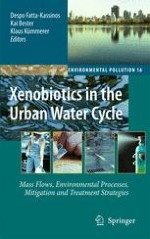2010 | OriginalPaper | Buchkapitel
6. Sources and Occurrence of Cyanotoxins Worldwide
verfasst von : Miguel Pelaez, Maria G. Antoniou, Xuexiang He, Dionysios D. Dionysiou, Armah A. de la Cruz, Katerina Tsimeli, Theodoros Triantis, Anastasia Hiskia, Triantafyllos Kaloudis, Christopher Williams, Mark Aubel, Andrew Chapman, Amanda Foss, Urooj Khan, Kevin E. O’Shea, Judy Westrick
Erschienen in: Xenobiotics in the Urban Water Cycle
Verlag: Springer Netherlands
Aktivieren Sie unsere intelligente Suche, um passende Fachinhalte oder Patente zu finden.
Wählen Sie Textabschnitte aus um mit Künstlicher Intelligenz passenden Patente zu finden. powered by
Markieren Sie Textabschnitte, um KI-gestützt weitere passende Inhalte zu finden. powered by
